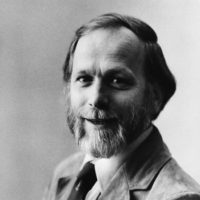
J. Michael Bishop
University of California, San Francisco
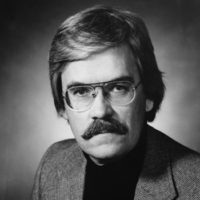
Raymond L. Erikson
Harvard University
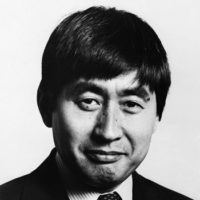
Hidesaburo Hanafusa
The Rockefeller University
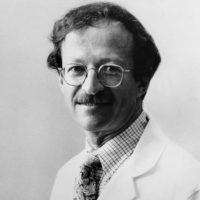
Harold E. Varmus
University of California, San Francisco
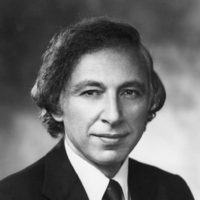
Robert C. Gallo
National Cancer Institute, National Institutes of Health
For the discovery that oncogenes are present in normal cells.
J. Michael Bishop
In a long and particularly close scientific collaboration with Dr. Varmus, Dr. Bishop showed beyond question that a DNA sequence in the avian sarcoma virus was virtually identical to a sequence in normal human DNA. Moreover, they show that this sequence occurred in the genome of all vertebrates with only subtle alterations reflecting the gene’s great age and the still mysterious, but vital identical role it must play.
Dr. Bishop extended his studies by showing that this was only the first of a number of distinct oncogenes expressed at inappropriate levels in neoplastic tissues. He also showed how retroviruses such as the avian sarcoma virus reproduce and integrate with the genetic material of the infected cell.
To Dr. Bishop, whose creative and technically unprecedented studies formed the foundation for a new comprehension of the molecular genetics of cancer, growth, cell differentiation, and of the genetic history of the human race, this 1982 Albert Lasker Basic Medical Research Award is given.
Harold Varmus
Dr. Varmus initiated studies showing that in normal animal cells, there resides a gene closely related to a gene carried by acutely transforming retrovirus, and that this ordinarily inactive gene, preserved throughout evolution, must play a crucial role in normal growth and development—although when inappropriately expressed or mutated, it may cause malignancy.
In close scientific collaboration, Dr. Varmus and Dr. J. Michael Bishop showed unequivocally that a genetic sequence in the avian sarcoma virus was homologous to a sequence in the normal DNA of vertebrates, including man. Whereas the cellular version of the gene is expressed at low levels in normal tissues, the viral version of the gene is efficiently expressed in virus-induced tumors and cells transformed by the virus.
By comparing the sequence now known at the “src” gene, as it occurs in the DNA of various species, Dr. Varmus and Dr. Bishop showed that the gene is conserved from species to species with other minor changes, indicating that its role must be important.
For his stunning discovery of the homology between acute transforming genes including the src gene, and its comparable sequence in normal cellular DNA which opened a new era of increasingly precise comprehension of cell differentiation, growth and development of living creatures, and of the molecular genetics of cancer, this 1982 Albert Lasker Basic Medical Research Award is given.
For contributions to the first identification and characterization of the protein products of oncogenes, thus providing a clearer understanding of cell growth and regulation.
Raymond Erikson
After it was established that cancer-causing retroviruses carry oncogenes, the first important step was to define the protein product coded by each of them. Dr. Erikson isolated the first one—the enzyme coded by the avian sarcoma virus oncogene. The protein product of this oncogene, which has a unique pattern of enzyme, drastically alters the biochemistry of the cell and diminishes its capacity for responding to regulatory signals from hormones. Of all the oncogenes now known, a substantial number seem to act in a similar way.
To Dr. Erikson, first to discover the protein product of an oncogene and to provide a model for other investigators to employ in their search for the products of other oncogenes—a pioneer within a field of pioneers—this 1982 Albert Lasker Basic Medical Research Award is given.
For demonstrating how RNA tumor viruses cause cancer, and elucidating their role in combining, rescuing and maintaining oncogenes in the viral genome.
Hidesaburo Hanafusa
Dr. Hanafusa’s studies and those of others discovered that when retroviruses reproduce, they give rise to a DNA copy of themselves known as a “provirus” with identical gene-activating “long terminal repeat” sequences at either end. These flanking sequences splice themselves into cellular DNA, making the provirus a part of the cellular blueprint.
Dr. Hanafusa then showed that retroviruses containing only a part of the src gene could produce tumors in animals. From these tumors he isolated virus which now contained the complete src gene sequence. The retrovirus, by means of its recombinant ability, had picked up the missing part of the src gene of the cells and thus became tumorigenic.
To Dr. Hanafusa, whose studies combining scientific imagination with meticulous laboratory techniques showed the mechanism by which retroviruses take oncogenes from normal cells and thus acquire the ability to cause malignant tumors, this 1982 Albert Lasker Basic Medical Research Award is given.
For the discovery of the first human RNA tumor virus and its association with certain leukemias and lymphomas.
Robert Gallo
Dr. Gallo’s early discovery of a T-cell growth factor which enables cells to be grown more readily in the laboratory has earned him the appreciation of countless other scientists. His years of persistent and single-minded research in virology have lead to broader and brighter prospects for cancer research, the development of a human cancer vaccine and other approaches to the prevention of human cancers.
Following his isolation of the T-cell growth factor, which stimulates T lymphocytes to divide and proliferate to fight an infection, Dr. Gallo undertook detailed research on T-cell leukemias—leading ultimately to a virus which activated inappropriately the gene coding for T-cell growth factor. T-cell growth factor is produced and T cells multiply wildly, producing more growth factor. This cycle leads to a virulent T-cell leukemia, rare in the US but common in Japan and in the Caribbean.
Dr. Gallo’s clinical and epidemiological studies have shown that the virus can infect some people without causing harm, but leads to leukemia in a susceptible few. Recent discoveries suggest that human T-cell leukemia virus or another similar to it may be involved in other types of disease.
To Dr. Gallo, for his tenacious and thorough investigations leading to the discovery of the human T-cell leukemia virus and carrying resounding implications that will reshape approaches to cancer much sooner than scientists had expected or humanity had hoped, this 1982 Albert Lasker Basic Medical Research Award is given.
J. Michael Bishop
Acceptance remarks, 1982 Lasker Awards Ceremony
One person out of every four here will develop cancer. One in every five will die of the disease. These are tragic dimensions, but they are no larger than the intellectual challenge cancer presents. Every minute, ten million cells divide in our bodies. The divisions usually occur in the right place, at the right time, in the right way—governed by mechanisms to which we cannot yet even give names. When the governance fails, cancer arises. Why does the governance fail? And how does it fail? These questions have consumed many lifetimes—those of Raymond Erikson, Robert Gallo, Hidesaburo Hanafusa, Harold Varmus and myself, to name a few. The answers have seemed very distant indeed.
On an early morning in 1925, Robin Fahraeus became the first person to witness a biological molecule sediment in a gravitational field. You might find this an abstruse event, but Fahraeus felt otherwise. He roused his colleague, The Svedberg, from sleep with a phone call and a memorable message: “The, I have seen a dawn.” As Fahraeus watched through a tiny glass window, the blood protein he had chosen for his experiments was moving down a centrifuge tube, leaving behind a yellow glow. Fahraeus knew from the glow that his experiment had worked. But he knew far more, as well. He knew that soon the structure of living matter would be laid out in fine detail, for all to see and understand. Molecular biology—the crowning glory of twentieth century life sciences—had been borne.
We are here today to note the coming of another dawn. After centuries of bewilderment, the human intellect has finally laid hold of cancer with a grip that may eventually extract the deadly secrets of the disease. The grip has been forged by many hands. My colleagues here today and I are fortunate beyond words to have been recognized for our contributions to the forging: There have been many others. We owe the strength of our newfound grip to the study of tumor viruses. The debt embodies a marvelous irony.
For decades, two schools of thought have battled over tumor viruses. One school argued that we should search for viruses in human cancer—that viruses must cause the disease. The other school held that the many causes of cancer matter less than the mechanisms by which the disease arises: tumor viruses should be used in laboratory experiments to ferret out the genetic and chemical processes that cause the cancer cell to run amok. Against all reasonable odds, both views have now been vindicated. The diversity and sweep of that vindication is reflected among the five scientists the Lasker Foundation honors today. Tumor viruses have been found in human cancer. None but the foolish—from whatever school—would dispute the provocation and advance this finding represents. And tumor viruses have revealed to us a set of human genes whose activities may lie at the heart of every cancer, no matter what its cause. The enemy has been found—it is part of us—and we have begun to understand the lines of its attack.
Robert Gallo has been at the forefront of the search for human tumor viruses. It has sometimes been a lonely search. His diligence and conviction have at last been fulfilled. Hidesaburo Hanafusa and Harold Varmus gave substance to the idea that we must all have cancer genes—that cancer is part of the genetic dowry of every living cell. Raymond Erikson uncovered how one of these cancer genes may wreak its havoc. And I—I composed this homily.
Will we be able to parlay these revelations into a strategy for the control of cancer? The issue remains in deep doubt. The road ahead seems long and daunting. And the outcome is not solely in the hands of scientists. Cancer research is a public endeavor—indeed, one of the boldest endeavors our society has attempted. No one understands this better than our hostess today, Mrs. Albert Lasker, to whose generosity and hospitality we are all indebted. I take this, my first opportunity, to thank her for her remarkable and untiring efforts in the quest for human welfare.
We need a thousand giants like her. Those of us who labor in cancer research look to our fellow citizens for mandate and support. And these are anxious times for biomedical research. The dollar now dictates what we can and cannot do to an extent that is damaging and demoralizing. We have no product to sell, now or for the foreseeable future. What we have is the hope that all of us together will enable humankind by seeing this great and hopeful adventure through to its end. We began this adventure together as a nation—in an act of altruism unprecedented in the annals of government. Let us finish it together as citizens rather than mercantalists.
Mrs. Lasker, Senator Hatfield, Dr. DeBakey and your jury, friends, and strangers—my colleagues and I thank you all—we are deeply honored to be here.
Listen to Michael Bishop on Dial an Idol, a podcast from the Lasker Foundation
In this episode: Emily Ashkin met Michael Bishop at a high school science fair. At the time, Emily didn’t feel like she belonged and Bishop gave her advice that still comforts her today.
Click here to hear more episodes of Dial an Idol.
